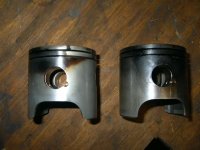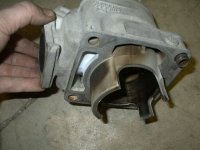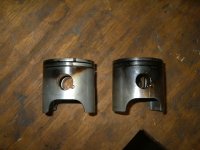Many guys think that a compression check tells them if they need to replace rings in their sled. A compression test simply tells you the engines ability to build pressure rapidly but what it doesnt tell you is how long you can hang onto that pressure. A compression test is good to see if the engine is in good operable shape as if you were buying a sled used, a good test would be if all 3 cylinders or 2 cylinders if a twin engine, 4 if a 4cyl engine would all be within a small percentage of each other. This means all the cylinders are not blown up or severly damaged with pinched rings from prior engine damage,etc.
With a compression test your reading will vary by certain amounts depending upon which brand of tester used and more importantly the hose length, and the thread adaptor used to screw into the spark plug hole. A long hose and short thread adaptor adds volume to the head and thus your reading will be lower then with a short hose and long thread adaptor. Dont concentrate on the number itself as long as all the cylinders are within reasonably close reading wise to each other.
A leak down test is what actually determines your rings ability to seal and tells the truth about their condition as per miles on them , etc.
Its all about how long you can keep the seal. When you have rings that are worn from miles put on the sled you will not "feel "a drastic change in performance. it happens over time slowly and you are used to it from the miles you keep putting on the sled but may notice the rpms are not what they used to be on topend, doesnt seem to pull the same clutch weight it did when new, the sled doesnt get as good of gas mileage, it doesnt hit the same topspeed numbers as before, etc. These are little hints as to the rings life span. The real life span is about 2500-3000 miles with good oil, they may "run just fine" but they wont be perfect beyond those miles. Worn rings contribute to contamination of the crankcase fresh fuel charge. With worn rings it allows exhaust gasses to leak past the rings and contaminte the fresh fuel charge below in the crankcase, this makes the charge less powerfull and richer as the exhaust gasses still contain fuel molcules yet to be completely burned. Teel tale signs of worn rings will be black on the piston sides, below the the second ring, this is the blow by gasses seeping below as described, you will also notice a blackish/brown film on the bottom and sides of the cylinder sleeves/castings, this is from worn rings also. I will post some pics to this thread to show examples of blow by.
I have posted a couple pics to show you what blow by looks like, you can see the bottom of the cylinder reinhaling the exhaust blow by back up into the transfer ports contaminating the fresh mixture in the crank case. On the 2 pistons notice how the blow by has gotten far below the wrist pin, helping to pass blow by into the crankcase. These engines both showed a good 120-125psi of compression, yet they failed the leak down to a tune of about 10-14%, they each have around 5000 miles. The differance in the wear comes from the use of the sled and the oil used, you can see which one used yamalube!
A 2 stroke engine relies heavily upon piston and ring seal as its the camshaft,valves, and heart of the engine. The 2 stroke also beats up the piston twice as much as a 4 stroke does. The loss of stability from worn rings leads to piston walking back and forth in the bore, this leads to premature skirt wear and eventually major engine failure will result. The piston begins to rock back and forth in the bore and will break off the intake skirt, sending large shrapnel thru the engine and will almost always break the crankcase bottom, from becoming wedged between the crank and case.
With a compression test your reading will vary by certain amounts depending upon which brand of tester used and more importantly the hose length, and the thread adaptor used to screw into the spark plug hole. A long hose and short thread adaptor adds volume to the head and thus your reading will be lower then with a short hose and long thread adaptor. Dont concentrate on the number itself as long as all the cylinders are within reasonably close reading wise to each other.
A leak down test is what actually determines your rings ability to seal and tells the truth about their condition as per miles on them , etc.
Its all about how long you can keep the seal. When you have rings that are worn from miles put on the sled you will not "feel "a drastic change in performance. it happens over time slowly and you are used to it from the miles you keep putting on the sled but may notice the rpms are not what they used to be on topend, doesnt seem to pull the same clutch weight it did when new, the sled doesnt get as good of gas mileage, it doesnt hit the same topspeed numbers as before, etc. These are little hints as to the rings life span. The real life span is about 2500-3000 miles with good oil, they may "run just fine" but they wont be perfect beyond those miles. Worn rings contribute to contamination of the crankcase fresh fuel charge. With worn rings it allows exhaust gasses to leak past the rings and contaminte the fresh fuel charge below in the crankcase, this makes the charge less powerfull and richer as the exhaust gasses still contain fuel molcules yet to be completely burned. Teel tale signs of worn rings will be black on the piston sides, below the the second ring, this is the blow by gasses seeping below as described, you will also notice a blackish/brown film on the bottom and sides of the cylinder sleeves/castings, this is from worn rings also. I will post some pics to this thread to show examples of blow by.
I have posted a couple pics to show you what blow by looks like, you can see the bottom of the cylinder reinhaling the exhaust blow by back up into the transfer ports contaminating the fresh mixture in the crank case. On the 2 pistons notice how the blow by has gotten far below the wrist pin, helping to pass blow by into the crankcase. These engines both showed a good 120-125psi of compression, yet they failed the leak down to a tune of about 10-14%, they each have around 5000 miles. The differance in the wear comes from the use of the sled and the oil used, you can see which one used yamalube!
A 2 stroke engine relies heavily upon piston and ring seal as its the camshaft,valves, and heart of the engine. The 2 stroke also beats up the piston twice as much as a 4 stroke does. The loss of stability from worn rings leads to piston walking back and forth in the bore, this leads to premature skirt wear and eventually major engine failure will result. The piston begins to rock back and forth in the bore and will break off the intake skirt, sending large shrapnel thru the engine and will almost always break the crankcase bottom, from becoming wedged between the crank and case.
Attachments
Last edited by a moderator:
A leak down test is quite simple to do, all you need is a kit like the pic posted and an air compressor. I simply bring the cylinder I want to check up to TDC, insert a wooden dowel, old broom handle or whatever thru the primary clutch across the bellypan, this way when you apply the air pressure to the cylinder it wont want to "spin" the engine down and lose all your pressure out the exhaust port.
Insert the thread adaptor, hook up the gauge unit and apply 100lbs of air pressure to the cylinder, shut off the regulator and wait. I wait 20-30mins and check what the pressure drop is. theres lots of differnt opinions as to whats acceptable and whats not, I personally dont like to see more then 5% loss, thats up to you what percentage you use.
What your checking isthe rings ability to keep a seal, this is the real indicator on how good of condition they are because even a engine with worn rings can show "ok" compression numbers on a compression guage simplyfrom the fast movement ofpulling it over, it can build pressurefast but if it canthang onto the pressure its leaking it down past the rings into the crankcase.
Insert the thread adaptor, hook up the gauge unit and apply 100lbs of air pressure to the cylinder, shut off the regulator and wait. I wait 20-30mins and check what the pressure drop is. theres lots of differnt opinions as to whats acceptable and whats not, I personally dont like to see more then 5% loss, thats up to you what percentage you use.
What your checking isthe rings ability to keep a seal, this is the real indicator on how good of condition they are because even a engine with worn rings can show "ok" compression numbers on a compression guage simplyfrom the fast movement ofpulling it over, it can build pressurefast but if it canthang onto the pressure its leaking it down past the rings into the crankcase.
Don or anybody else . . .
Have you guys ever done a crankcase leakdown test on a Yamaha? This is a test where you close off all crankcase openings (intake, exhaust, exhaust valve, spark plug, breather, oil, etc.) and then put 5-10 psi of pressure in the crankcase. You check later to see if it held or not. This test is very helpful in finding leaks in the cases that might not be visible.
SkiDoo used to put this test right in the service manual for many engines including the rotary valve ones. The rotary shaft engines tended to be such good engines that the seals on the rotary shaft would fail before the engine wore out (coolant in the oil, and oil in the coolant). This was one way to pinpoint this problem.
Just wondering if this is an outdated test or still a valid one.
Have you guys ever done a crankcase leakdown test on a Yamaha? This is a test where you close off all crankcase openings (intake, exhaust, exhaust valve, spark plug, breather, oil, etc.) and then put 5-10 psi of pressure in the crankcase. You check later to see if it held or not. This test is very helpful in finding leaks in the cases that might not be visible.
SkiDoo used to put this test right in the service manual for many engines including the rotary valve ones. The rotary shaft engines tended to be such good engines that the seals on the rotary shaft would fail before the engine wore out (coolant in the oil, and oil in the coolant). This was one way to pinpoint this problem.
Just wondering if this is an outdated test or still a valid one.
That would still be a very valid test of the crank seals , crankcase halves sealing. Youd need to make 3 solid reed blocks, 3 exh port block offs, have the sparkplugs in and test it off the vacum pulse port on rear of case. Used to do this on the cr500 dirtbike engines and then spray soapy water on them to help detect hidden leaks.
taylzee
New member
Could you not test the reeds here too? I may be way off base here but couldn't you be at BDC and block off the exhaust, pressure to 5-10PSI and check the reeds?
mopar1rules
Active member
here is a link to one that i've built for my banshee. i used a mitivac vaccum pump, versus the hospital style bulb pump. you guys could build something similar for the sleds. also, motion pro sells a leak down tester, but its pretty spendy.
http://www.bansheehq.com/forums/index.php?showtopic=49835&hl=
http://www.bansheehq.com/forums/index.php?showtopic=49835&hl=
- Status
- Not open for further replies.






